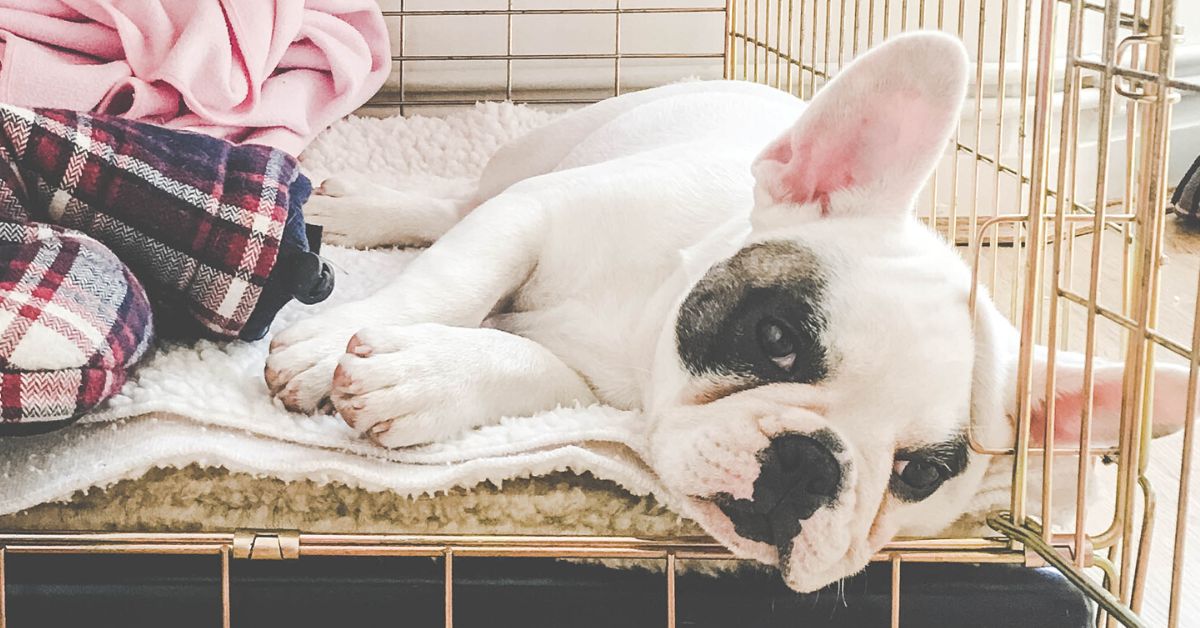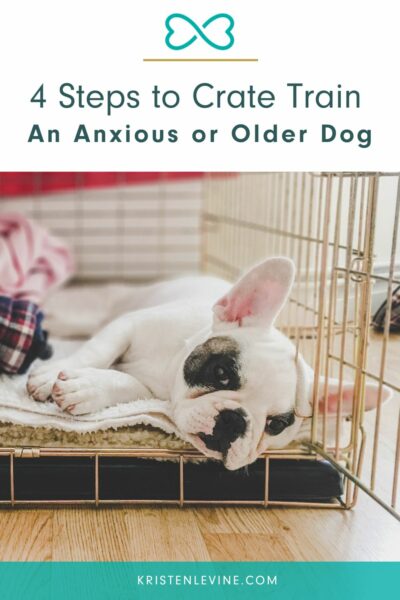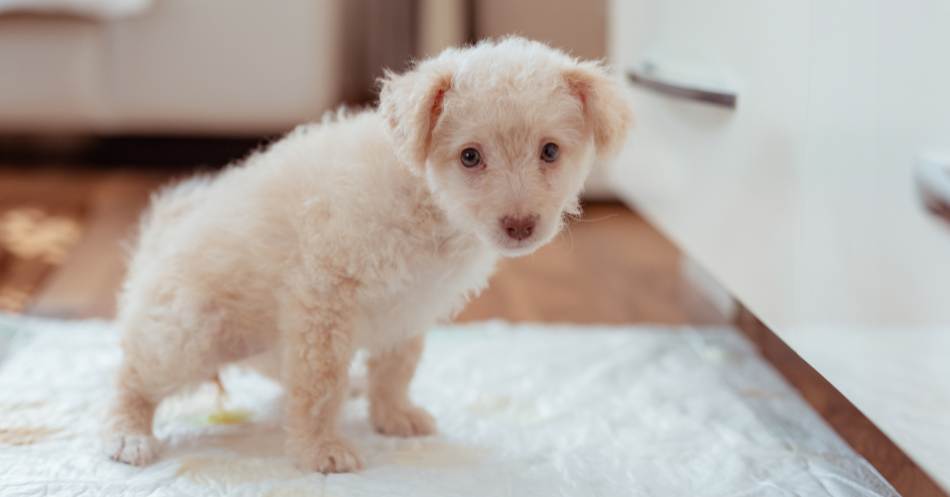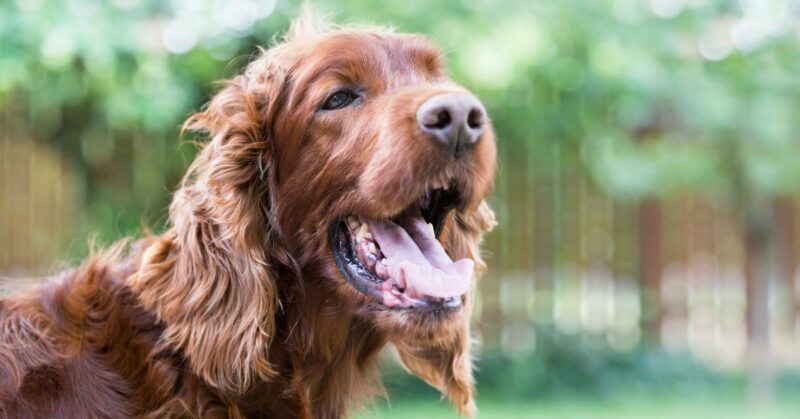
How to Crate Train an Older Dog or Anxious Pup in 5 Steps
This post may include affiliate links. Please read my disclosure policy.
If your dog is older or has anxiety, crate training can seem monumental! With planning and these expert tips, you and your pup will be singing (or barking) the praises of crate training.
What is Crate Training?
A crate is a practical way to manage and train adult dogs. New pet parents find using a crate essential in potty training their new four-legged family member.
Crates also allow you to limit your dog’s access to parts of your home. As a result, your pup stays in a secure location. They also provide them with a safe retreat when your dog is stressed out by visiting guests or loud noises.
In reality, crates are useful far beyond your home. Adult dogs are often crated at their veterinarian’s office, the groomer’s, and boarding facilities while traveling and even during natural disasters.
If your older or anxious pup hesitates to step one paw inside a crate, the interior can be filled with your dog’s favorite crate mattress, blankets, and favorite toys to create a warm, inviting den.
Why Is Crate Training Helpful for Anxious Pups and Adult Dogs?
Perhaps you’ve recently adopted an adult dog, never got around to crate training your pooch, or your fur family is showing signs of stress and anxiety—whatever the scenario, crate training can prove invaluable.
There are moments in life when it’s much safer for your pup (and safer for you) that they are confined to one area:
- During emergencies and natural disasters
- When traveling with your dog
- Trips to the veterinarian
- Confinement during illness, injury, and recovery
- To provide a calm, safe space in stressful situations
Pin me!

How to Crate Train Older or Anxious Dogs
Knowing how to crate train an older dog shouldn’t be a tricky process. Ideally, dog moms and dads should start young when training their pups. But adult dogs and even puppies who struggle with separation anxiety can benefit from crate training too.
Senior Dogs: The crate training process can be tricky if you didn’t have the opportunity to train your dog from their formative years. But don’t worry; it isn’t too late. Humans may think we “can’t teach an old dog new tricks,” but that isn’t true. Older dogs can learn new habits; it just may require more patience and repetition from their pet parents.
One dog mom told me about her experience crating her senior dog. Pamela said her dog, Pepper, was never crated until she reached 14 years old and began experiencing cognitive decline. Pamela was renting a new home and was worried about how Pepper would react to being in a new place.
She was also concerned that a crate might feel too confining for Pepper. However, she said, “I was so glad we got her used to a crate. It became her spot where she felt safe. We called it her house because it was her own.”
Most pet parents find the benefits far outweigh the hard work. Your dog will be safer in emergencies than if they were on a harness or left alone. Training an older dog to use the crate is a positive reinforcement at times like these.
If you’ve recently adopted an older dog, they may get anxious as they adjust to their new home and have potty training accidents. Typically, dogs won’t soil their personal space (unless there are medical issues), so a crate can be helpful as your new dog adjusts.
And compared to a rambunctious puppy, your older dog, like Pepper, will likely relish their crate’s cozy, quiet, den-like hideaway.
Anxious Dogs: Crate training won’t cure your pup’s anxiety. But it can cut down on some of their nervous behaviors. The most effective way to treat your dog’s anxiety is to consult your veterinarian and learn more about the training sessions on crates for anxious dogs.
They can give you expert help, including prescription medications, natural solutions, and lifestyle changes to calm your pet. In conjunction with crate training, these adjustments can help your fur friend regain their calm.
Before visiting your veterinarian, you might familiarize yourself with the causes and solutions for dog anxiety so you can make the most of your visit by asking your veterinarian the right questions.
You can learn all about dog anxiety right here on my blog.
Crate Selection and What to Do Next
A crate can help an anxious dog feel safer if loud noises like thunder or fireworks trigger them. And if your pup suffers from separation anxiety, they may feel comforted by having a safe, enclosed space to retreat to.
- Make the crate appealing. Choose a crate that’s large enough for your dog to lie down, stand up, and turn around comfortably. Add a soft blanket or a plush crate bed like this one from my friends at Snoozer Pet Products.
- Use tasty dog treats and fun toys. Your pup may initially hesitate to get near their crate. So there’s nothing wrong with enticing them with a yummy treat or their favorite interactive toy. Doing this builds positive associations. Praise your older pup when they retrieve the treat or toy. Get your pooch their favorite toy to keep them busy and curb their anxiety.
- Encourage your dog to enter their crate. Once your pup is comfortable inside their crate, try moving their toys, treats, and water bowl inside. Gradually move the items from the front of the crate to the back until your dog is fully inside.
Again, remember to praise your dog for these baby steps! Leave the door open and encourage your dog to come and go as they please.
- Try closing the crate’s door. This is where patience and perseverance will really pay off. Once your dog is inside their crate, close the door for several seconds before letting it out. Keep repeating this step, gradually adding more time as you go.
When your dog is comfortable, you can increase the time by minutes and even up to an hour or more. Providing meals, toys, and treats in the crate will develop positive associations and help your furry friend adjust to this new space comfortably.
- Keep calm. Crate training our older pups is as much about our attitude as it is about teaching them new tricks. Dogs often pick up on our emotions. Making a big deal when leaving or when coming back home may cause unnecessary anxiety or excitement for your pup. The golden rule? Keep calm and train on.
Keeping a cool, calm, and collected demeanor can put our dogs at ease, and can also teach them that transitions—stepping out or coming home—are not a big deal. Over time, they’ll learn that their crate time is actually a reward rather than a cause for anxiety. This helps turn crate training from an uphill battle into a walk in the park.
Note: If your dog panics or gets stressed during training, let them out of their crate for a break. Setbacks are a part of the process. But with regular training, you and your dog will be more comfortable using a crate.
What to Do if Your Pup Whines or Barks
It’s fully expected your dog may not like their crate right away and they may howl, whine, or bark when you first get started. And while we don’t want to leave an upset dog in their crate for an extended length of time, they do need to learn that being quiet and calm in their crate is the goal.
Start training with short periods of crate time. Begin with five to ten minute sessions, and work your way up to longer periods of crate time as your dog learns to find comfort and calm in the crate.
Once your dog starts whining or barking excessively, respond, but make sure you don’t reinforce this behavior. So, no immediate cuddles or letting them out of the crate when the whining or barking starts.
Instead, reinforce quiet behavior. Wait for a lull in the barking or whining, even if it’s only a few seconds of silence, and then reward them. The reward could be a tasty treat, a calming pat, or soothing praise. Over time, they’ll start to realize that keeping quiet is their ticket to good things!
It takes time to crate train an anxious or older dog. However, if your dog has moderate to severe fear, stress, or anxiety, you may need to consult with a veterinary behaviorist before starting them on this training.
What Type of Crate To Buy
Not only is it essential to properly train your dog to use their crate, but it’s also vital to choose the best crate for your dog and their circumstances.
Like your fur family, dog crates come in all shapes and sizes. Each style has its unique advantages to fit your dog’s needs. Here are a few favorites among the Pet Living Team:
1. Wire crates are easily portable and collapse for stream-lined storage. This wire crate comes in sizes ranging from 22 to 48 inches. It assembles in seconds, without any tools, and conveniently folds flat for travel and easy storage.
- Added security features to keep your pet safe and secure
- Includes a divider panel, durable & leak-proof plastic pan, protective rubber feet, and carrying handle
- Easy to assemble & portable
- Durable & strong with proper ventilation, large door openings with low thresholds, and patented rounded corner clips
In addition to a leak-proof liner, it features the patented Paw Block slide bolt, which prevents your dog from tampering with the door lock inside the crate. And if your pup struggles with anxiety, a crate cover like this can give them added privacy while still providing proper ventilation.
2. Soft-sided crates like this one are paws down the way to go for smaller breeds. This particular crate by Petsfit is made with durable cloth and stainless steel inner supports.
Compared with metal crates, this lightweight option is great for traveling and camping.
Pamela used this type of crate for Pepper. Since senior dogs may be less likely to try and chew through the fabric, soft crates can be an excellent option to get them used to crating.
- Crates available for all sizes of dog from Dachshunds to German Shepherds
- Adjustable and washable cloth cover
- Internal stainless steel pipes are constructed as a solid piece without any foldable parts in the middle
- Reinforced seams and zipper for strength and mesh doors on three sides for ventilation and visibility
- Lockable zippers for safety
3. The High Anxiety Crate from Impact Dog Crates is specifically designed for dogs with severe anxiety. As much as we’d love to spend every waking moment with our fur family, it’s impossible.
When some dogs are left alone, they suffer from separation anxiety, causing them to feel stressed and unhappy until their human family returns home.
A tell-tale sign of a dog with separation anxiety is destructive behavior. When left alone, they may claw, chew, and shred everything in your home, from shoes to furniture and even doors.
The High Anxiety Crate by Impact Dog Crates is engineered to keep your anxious pup (and your home) safe. It’s welded and riveted together for maximum strength, providing a secure and durable solution for dogs trying to escape their crates’ safety.
At Pet Living, we also love this crate’s small ventilation holes. They provide adequate airflow but are just the right size so your pup doesn’t get their teeth stuck, causing injury to themselves.
If your pup gets anxious and is a master of escape, this crate is just for them! They’ll feel calmer and more secure in their private den.
Use my affiliate code PETLIVING to get 15% off your order!
The Final Woof
Every dog will respond differently to crate training. Some may take to it naturally, while others require extra effort, encouragement, and time. So stay patient and consistent.
The key elements for successful crate training, however, depend on your dog’s size and temperament. The crate should be large enough for them to stand, turn around, and lie down comfortably but not so big that they could use a corner as a bathroom.
A comfortable and inviting crate will help your dog associate it with positive experiences, which should expedite the training process.
Crate training an older dog or a dog with anxiety is a great way to keep them safe and prepared for emergencies, travel, and recovery from illness. With the right crate, a little patience, and perseverance, your fur family will be enjoying the cozy comforts of their crate in no time!











Comments (0)